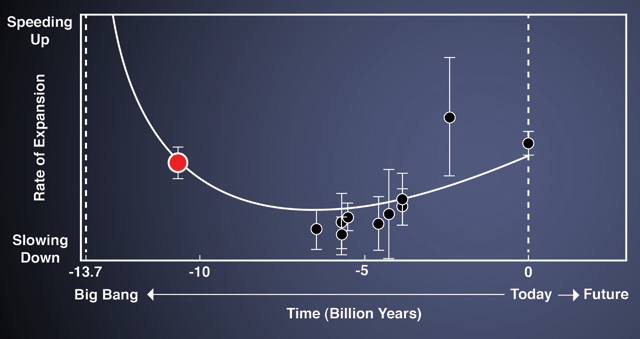Baryon acoustic oscillations (BAO) are the acoustic (sound) waves that occur in the very early universe due to very small density inhomogeneities in the nearly uniform fluid. These primordial acoustic oscillations have left an imprint on the way in which galaxies are spatially distributed. The characteristic scale length for these oscillations is around 500 million light years (in the frame of the present-day universe). A spatial correlation function is used to measure the degree to which galaxies and clumps of matter in general, including dark matter, are separated from one another. The characteristic length scale serves as a standard ruler for very large-scale clustering, and is seen as a distinctive break (change in slope) in the power spectrum of the degree of spatial correlation vs. distance.
An international consortium of astronomers representing 29 institutions have submitted a paper last month to the journal Astronomy and Astrophysics; the current version can be found here (http://arxiv.org/abs/1211.2616). They used a clever technique of detecting clouds of neutral hydrogen along the line of sight to a large number of quasars with high redshifts. Thus the matter clumps in this case are neutral hydrogen clouds or neutral hydrogen within intervening galaxies or proto-galaxies. These absorb light from the quasar and produce absorption lines in the spectrum at discrete locations corresponding to various redshifts. The authors are detecting a characteristic transition known as the Lyman alpha line, which is found well into the ultraviolet at 121.6 nanometers (for zero redshift).
For this work over 48,000 high-redshift quasars, with a mean redshift of 2.3, were taken from the 3rd Sloan Digital Sky Survey. A quasar may have many hydrogen clouds intervening along the line of sight from the Earth to the quasar. These clouds will be seen at different redshifts (less than the quasar redshift) reflecting their position along the line of sight. This is referred to as the Lyman alpha “forest”. This study is the first application of Lyman alpha forest measurement to the detection of the BAO feature. At the average red shift of 2.3, the wavelength of Lyman alpha radiation is shifted to 401.3 nm [calculated as (1+2.3)*121.6 nm], in the violet portion of the visible spectrum. The study incorporated redshifts from the absorbing clouds in the range of 1.96 to 3.38; these are found in front of (at lower redshift than) quasars with redshifts ranging from 2.1 to 3.5.
Speedup or slowdown versus age of universe. The Big Bang is on the left, 13.7 billion years ago.
The authors’ measurement of the expansion rate of the universe is shown as the red dot in this figure. The white line through the various data points is the rate of expansion of the universe expected versus time for the standard Lambda-Cold Dark Matter cosmological model. The expansion rate at early times was lessening due to gravity from matter (ordinary and dark), but it is now increasing, since dark energy has come to dominate during the last 5 billion years or so. The red data point is clearly on the slowing down portion of the curve. Image credit: http://sdss3.wordpress.com/2012/11/13/boss-detects-baryon-acoustic-oscillations-in-the-lyman-alpha-forest-at-z-of-2-3/
The BAO feature has been measured a number of times, using galaxy spatial distributions, but always at lower redshifts, that is at more recent times. This is not only the first Lyman alpha-based measurement, but the first measurement made at a high redshift for which the universe was still slowing down, i.e. the expansion was decelerating. At the redshift of 2.3, when the universe was only about 3 billion years old, the gravitational effect of dark plus ordinary matter was stronger than the repulsive effect of dark energy. It is only more recently, after the universe become about 9 billion years old (some 5 billion years ago), and corresponding to redshifts less than about z = 0.8, that dark energy began to dominate and cause an acceleration in the overall expansion of the universe.
Since this observation shows a significantly higher rate of expansion than occurred at the minimum around 5 billion years ago, it is further evidence that dark energy in some form is real. As the authors state in their paper: “Combined with CMB constraints, we deduce the expansion rate at z = 2.3 and demonstrate directly the sequence of deceleration and acceleration expected in dark-energy dominated cosmologies.” This is an exciting result, providing additional confirmation that dark energy represents around three-quarters of the present-day energy balance of the universe.

